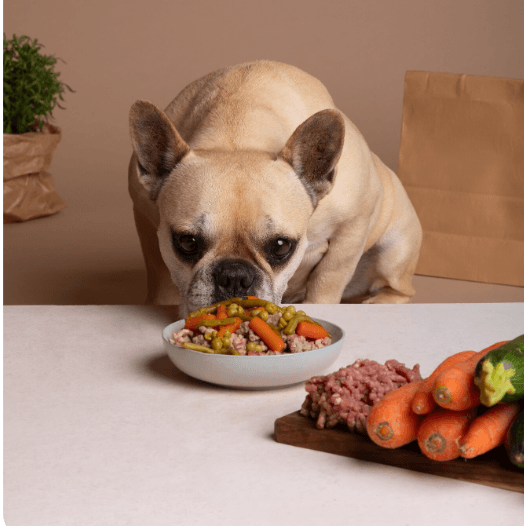
The debate between raw and cooked food for dogs is a complex one, with passionate advocates on both sides. Understanding the nuances of each diet, including their benefits and risks, is crucial for pet owners seeking to provide the best nutrition for their canine companions.
For pet dogs, gently cooked fresh food is generally considered better than raw food due to enhanced safety, improved digestibility, and proven longevity benefits, while still retaining high nutritional value. While raw diets aim to mimic ancestral eating habits and offer certain benefits, they carry significant risks related to bacterial contamination and nutritional imbalances that are largely mitigated by proper cooking.

Raw dog food typically consists of uncooked meat, bones, organs, and sometimes raw eggs, dairy, fruits, and vegetables. Proponents argue that this diet closely resembles a dog's ancestral diet, preserving natural nutrients, enzymes, and vitamins that might be destroyed during cooking.

Raw diets are believed to retain more natural nutrients, enzymes, and probiotics that can be lost during heat processing. Many owners report a shinier coat and healthier skin, attributed to the natural fats and oils in raw meat. Some studies suggest raw diets can enhance digestion due to naturally occurring enzymes and higher moisture content.
Chewing on raw bones is thought to help reduce plaque and tartar buildup, promoting better dental hygiene. Raw diets, often protein-centric and low in fillers, may help in maintaining an ideal weight.
This is the most significant concern. Raw meat can harbor harmful bacteria like Salmonella and E. coli, posing risks to both dogs and humans handling the food. A study found that dogs consuming raw meat had an increased risk of excreting ciprofloxacin-resistant E. coli. Homemade raw diets, if not meticulously formulated by a veterinary nutritionist, can lead to serious nutritional deficiencies or excesses, such as imbalances in calcium and phosphorus.
Studies have shown that a significant percentage of both homemade and commercial raw diets have nutritional imbalances. Whole raw bones can be a choking hazard, cause fractured teeth, or lead to life-threatening internal punctures or obstructions. Raw diets, especially those including wild-caught meats, can introduce parasites like tapeworms and toxoplasmosis.
Raw food requires careful storage and handling to prevent bacterial growth and cross-contamination in the kitchen. Major veterinary organizations, including the American Veterinary Medical Association (AVMA) and the American Animal Hospital Association (AAHA), officially recommend against feeding raw meat-based diets due to pathogen risks.

Cooked dog food, particularly gently cooked fresh food, involves lightly processing whole, unprocessed ingredients like meat, fish, fruits, and vegetables. This approach aims to eliminate pathogens while preserving nutritional value.
Cooking food at appropriate temperatures effectively kills harmful bacteria and parasites, significantly reducing the risk of foodborne illnesses for both pets and humans. Heat can break down cell walls and complex carbohydrates, proteins, and fats, making nutrients more accessible and digestible for dogs. This is particularly beneficial for senior dogs or those with compromised digestive systems.
Scientific studies have indicated that dogs fed homemade or fresh diets can experience a significant increase in lifespan. One study found a 20% increase in longevity, potentially adding up to 32 months (nearly 3 years) to a dog's life expectancy. Research suggests that dogs eating fresh food have lower pro-inflammatory markers, contributing to better health as they age.
Preparing homemade cooked meals allows pet owners to control the exact ingredients, avoiding fillers, preservatives, and artificial additives commonly found in commercial dog foods. Gently cooked diets typically contain 60-65% moisture, contributing to better hydration compared to dry kibble.

While gentle cooking aims to minimize this, some heat-sensitive nutrients, particularly certain vitamins (like vitamin C and B vitamins) and enzymes, can be reduced. However, a balanced diet can still provide necessary nutrients. Preparing homemade cooked meals can be time-consuming and requires careful planning to ensure nutritional completeness.
High-quality, fresh-cooked food can be more expensive than conventional kibble due to the quality of ingredients and preparation. Cooked food does not offer the same teeth-cleaning benefits as chewing on raw bones, necessitating additional dental care.
The primary distinction between raw and cooked food lies in the processing and the associated safety and digestibility profiles. While raw food advocates emphasize mimicking ancestral diets, the scientific community largely points to the risks of pathogens and nutritional imbalances in raw diets. Cooked food eliminates the risk of bacterial contamination, a major concern with raw diets.
Cooking generally makes nutrients more bioavailable and easier for dogs to absorb. While homemade raw diets often struggle with nutritional balance, commercially prepared fresh-cooked foods are typically formulated by veterinary nutritionists to meet AAFCO (Association of American Feed Control Officials) standards for complete and balanced nutrition. Raw food requires freezing and careful defrosting, which can be inconvenient, whereas some gently cooked fresh foods can be stored in the cupboard until opened.
Ultimately, the choice between raw and cooked food depends on individual circumstances, including the dog's health, age, specific needs, and the owner's ability to safely and consistently prepare a nutritionally balanced diet. However, given the scientific evidence regarding safety, digestibility, and longevity, gently cooked fresh food presents a more advantageous and safer option for most pet dogs. It offers the benefits of whole, natural ingredients without the significant risks associated with raw feeding. Consulting with a veterinarian or a board-certified veterinary nutritionist is always recommended before making significant dietary changes for your dog.